Funky Zebra is a fictional design agency which was created for one of my classes in Academy of Art, for a course called, Balancing Creativity and Profitability. We were given a fictitious client (our instructor) called, Trend Central, focusing in the fashion industry. Funky Zebra is composed of two more members plus myself.
We were tasked to do the following: research about the current fashion trends, do a competitive analysis, create three personas, state the scope of work, define success metrics, recommending which hosting site and e-commerce platform would work best for a fashion brand, show the development process, and lastly create a budget proposal for a website. At the end of the semester, Trend Central had to choose (from three groups) which design agency would represent their brand.
Why do we call ourselves Funky Zebra?
Because we believe that every client we work with deserve a one of a kind branding and design. Just like a zebra's stripe, no two zebras have the same stripe pattern.
Personalization will become increasingly important to consumers. According to an Accenture Interactive study,“56% of consumers are more likely to shop at a retailer in store or online that recognizes them by name.” Personalization in retail has been around for years now. Unfortunately, the tactics retailers once used to speak directly to customers (such as using first names in an email) have become outdated and transparent in the eyes of those very customers. At the same time, though, consumers are searching more and more for personalized shopping experiences they can really connect with, so 2017 should see retailers testing new ways to appeal to this desire.
Free shipping is no longer an option; it’s a requirement in today’s world. The name of the new game? Speed. Consumers might not want to actually make the trip to physical locations, but they still want the instant gratification of taking their purchases home immediately. The best way to accommodate this? Same-day shipping. A recent study by Temando found that “80% of shoppers surveyed want same-day shipping, while 61% want their packages even faster — within 1-3 hours of placing an order.”
Already, for the first time ever, men are outspending women by 13% and early indicators predict that the menswear market will expand 8.3% next year (“The Boutique@Ogilvy 2016 Men’s Shopping Report”). That’s 1.5 times more than women’s.
Nearly 60% of households (58%, according to the Food Marketing Institute) share shopping responsibilities. For food retailers, this could mean more baskets, which is great for sales, but it introduces communications challenges. Retailers will want to examine household data, if possible through reward programs, to better identify individual shopper preferences within households.
At the end of 2016, projections say there will be 447.9 million mobile payment users worldwide. TechCrunch estimates that 70 percent of all mobile users in the United States will make a mobile payment in 2017, mobile payments in general next year are expected to total $60 billion, and if you take Business Insider’s word for it, by 2020 mobile payments will account for $503 billion in sales. It’s pretty clear where the retail industry is headed in terms of payments — at least for now. Retailers who don’t soon implement mobile payment solutions will fall behind and risk losing out on sales. And if the predictions are any indication, missing out on those sales could mean missing out on a lot of money. It is best that companies implement Apple Pay and/or Android Pay.
While these impressive sales figures bode well for fast growing e-commerce organizations, it's important to note fraudsters are also shifting their focus to online businesses. Findings from our 2016 ThreatMatrix Cybercrime Report indicate a 52% increase in online security breaches compared to the first quarter of 2015.
There are various types of e-commerce threats. Some are accidental, some are purposeful, and some of them are due to human error. The most common security threats are phishing attacks, money thefts, data misuse, hacking, credit card frauds and unprotected services.
We want Trend Central to come out on top when it comes to the e-commerce world. In order for us to make Trend Central the number one e-commerce company when it comes to customization, we will have to study their three main competitors. Their three main competitors are, Zazzle, Spread Shirt, and CustomInk. If we want Trend Central to be on top, we will have to make a thorough analysis of their competitors.
Each company is unique in their own way and Funky Zebra will do their best to break down the competitors in terms of their widget, what sets their website apart from others, and what deters potential customers.
Zazzle is an American online marketplace that allows designers and customers to create their own products with independent manufacturers (clothing, posters, etc.), as well as use images from participating companies. Zazzle has partnered with many brands to amass a collection of digital images from companies like Disney and Hallmark. Zazzle claims to have over 300 million unique products listed on the site.
Social media integration:
Facebook, Twitter, Instagram, Pinterest, and Youtube.
3 ways to make money:
Zazzle provides more than one platform for users. It provides a platform for Designers to publish their Designs. For makers to sell their products, and, for people to promote their favorite products through an associates account.
Built in widget:
There is a built-in widget with models wearing the T-shirts as well as different angles.
Zazzle offers a lot of different types of products which also makes its site very cluttered and busy. This can put off potential visitors when visiting to buy something fast and specfic.
The widget is once entered to personalize with text and/or images and after doing that, it becomes a different page which is complicated and not clean or straightforward.
You cannot shop on Zazzle without creating an account. This again could warn off visitors who simply want to skim by and by something specific and fast.
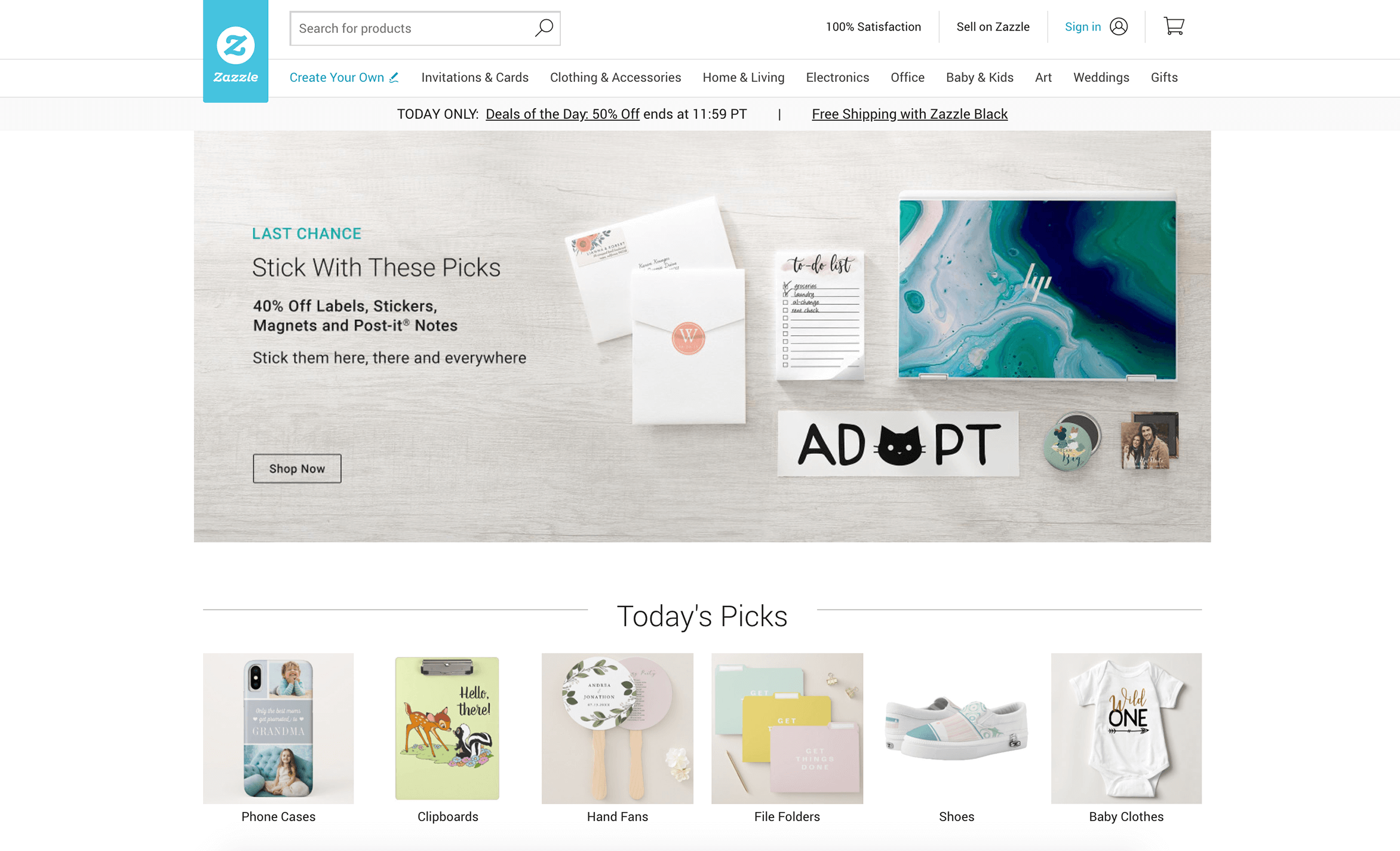
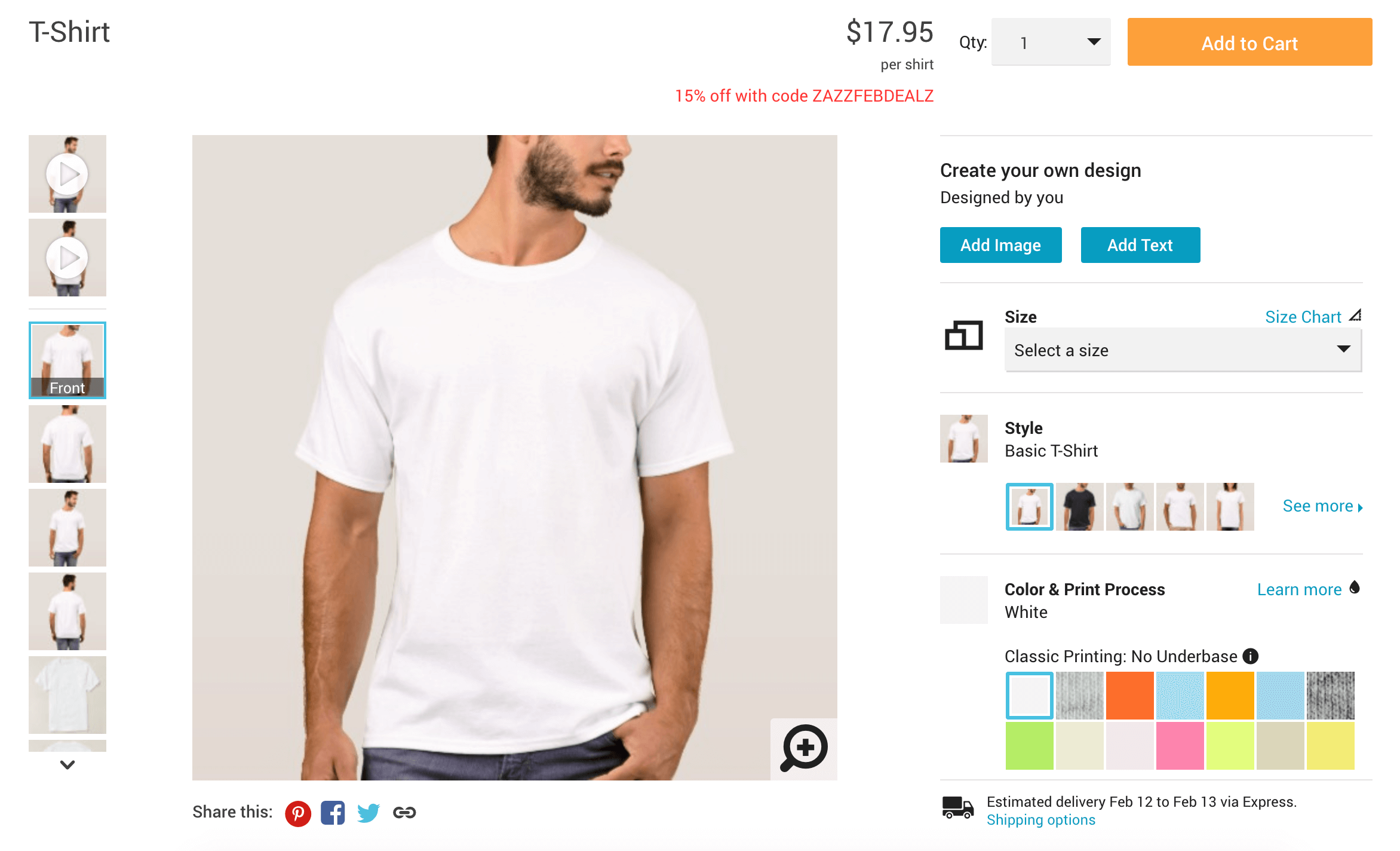
Spreadshirt GmbH is a German online retail company that enables customers to design and order custom apparel such as T-Shirts and sweatshirts. Customers can make, buy, and sell their designs on the Spreadshirt retail marketplace. While maintaining its headquarters in Leipzig, Spreadshirt has opened up European branch offices in Berlin, Germany; Paris, France; the city of Utrecht in the Netherlands. It has expanded to the United States with major locations in both the Pittsburgh suburb of Greensburg, Pennsylvania[4] and Boston, Massachusetts.
Social media integration:
Facebook, Twitter, Instagram, Pinterest, and Youtube.
Bulk orders:
Spreadshirt allows for users to purchase customized T-Shirts in bulk orders. There is also discount prices depending on how many are purchased.
Built in widget:
There is a built-in easy to use widget with templates, designs and texts all readily available or the choice to create your own design also.
Their site is pretty boring and outdated. They only seem to provide multiple cheap t shirt designs for one off events or organisations. There is no artistic design.
You cannot shop on CustomInk without creating an account. This again could warn off visitors who simply want to skim by and by something specific and fast.
Their products seem very cheap and unfashionable. There does not seem to be much variety in terms of style.
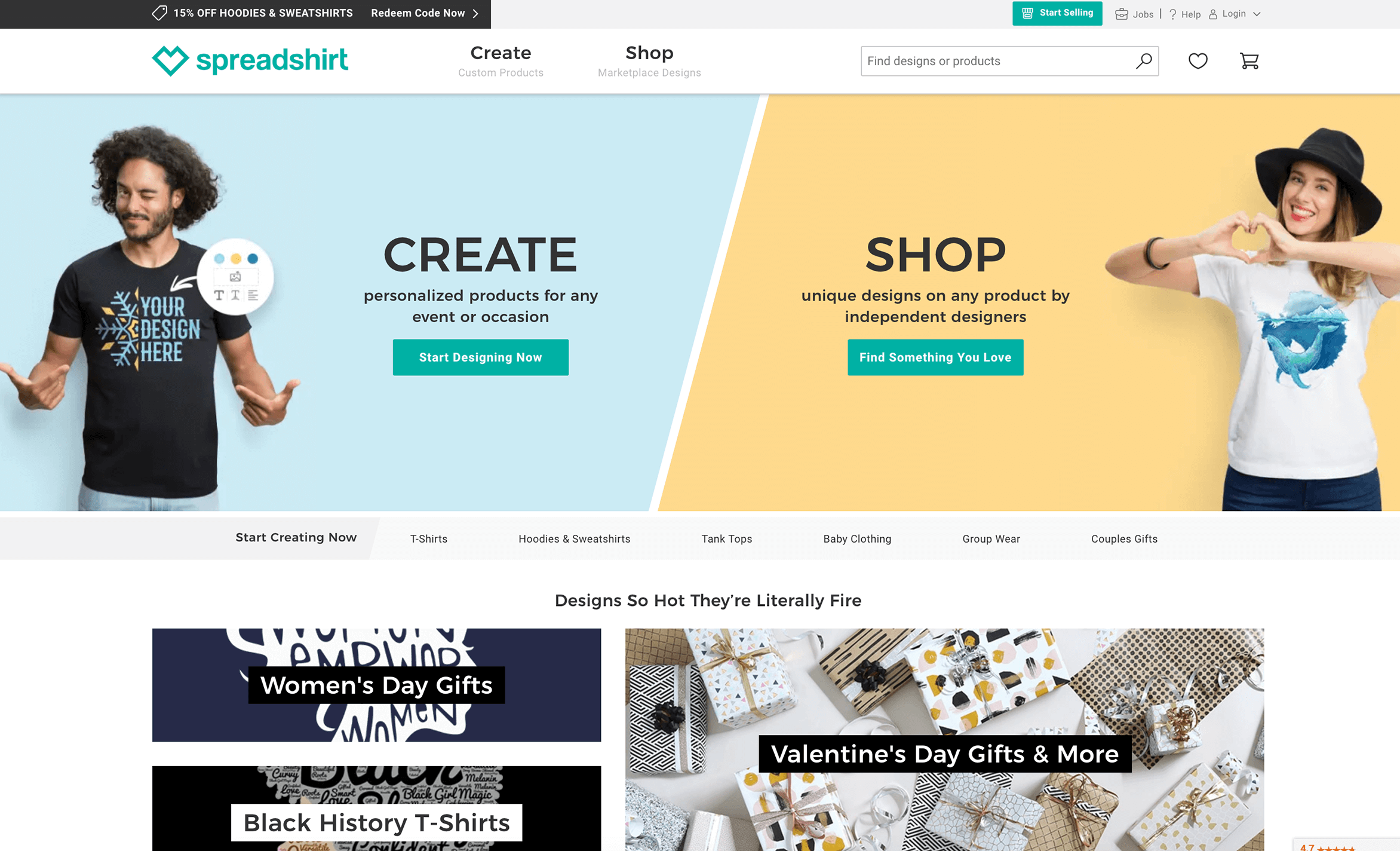
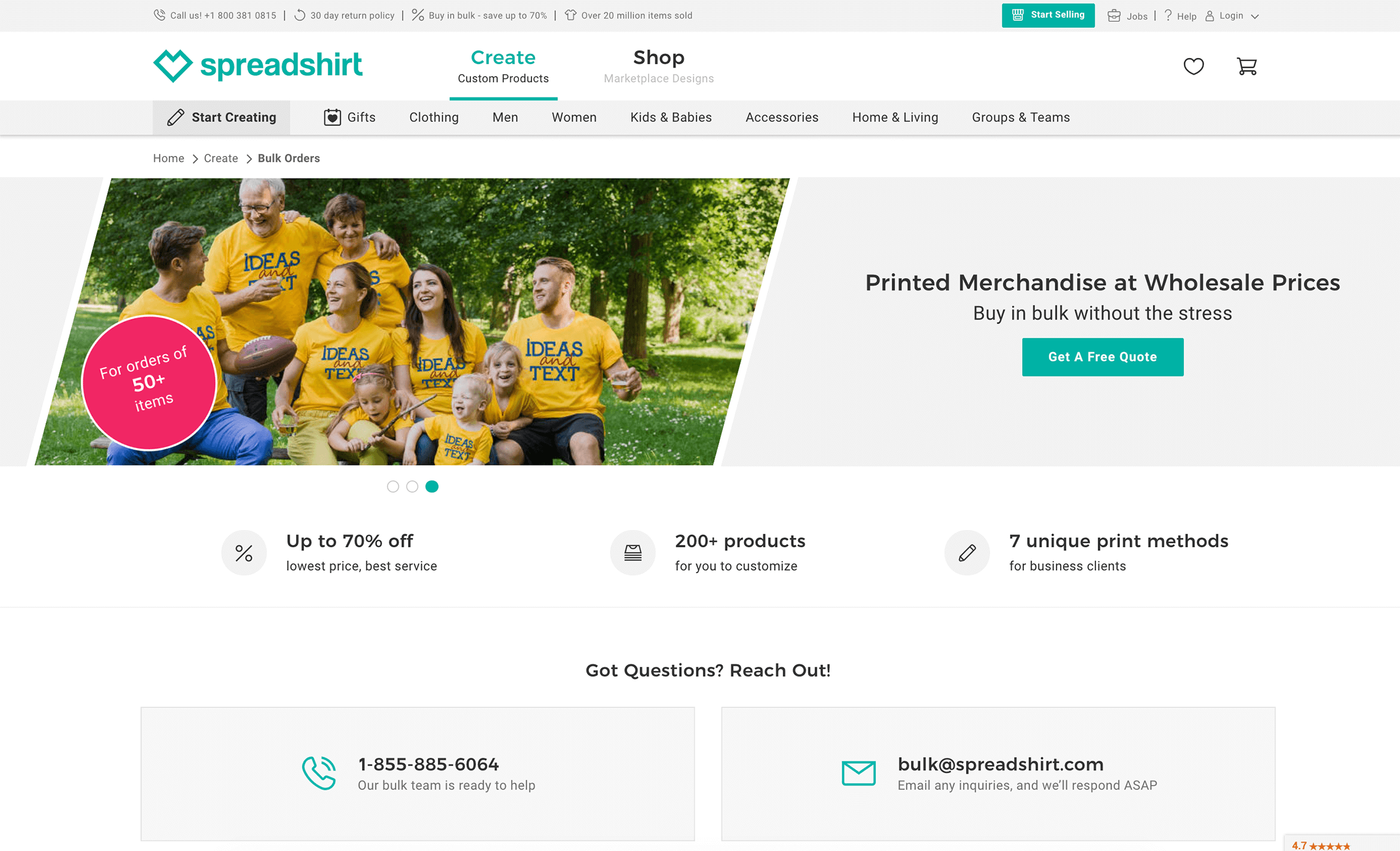
CustomInk is an American-based online retail company that makes custom apparel such as T-shirts and sweatshirts. Customers can upload their own art, or use the site’s design tools to create a design and order the customized product. CustomInk is headquartered in Fairfax, Virginia with additional offices in Reno, Dallas, and Charlottesville. As of 2015, CustomInk has expanded to Boston and Chicago to accommodate their Booster and Pear projects launched in 2014 and 2015.
Social media integration:
Facebook, Twitter, Instagram, Pinterest, and Youtube.
All inclusive pricing:
CustomInk provides all customers with a flat rate price for all customized designed products. No set up fees etc.
Built in widget:
There is a built-in easy to use widget with templates, designs and texts all readily available or the choice to create your own design also.
Live chat feature for 24/7 support.
Spreadshirt only offers T-Shirt designs and does not sell any other personalized items.
Spreadshirt only is available for support and questions from Monday-Friday with limited hours. This could potentially lose them sales when people are experiencing issues on the site as well as those who work full time weekday hours and shop on the weekends.
You cannot shop on Zazzle without creating an account. This again could warn off visitors who simply want to skim by and by something specific and fast.

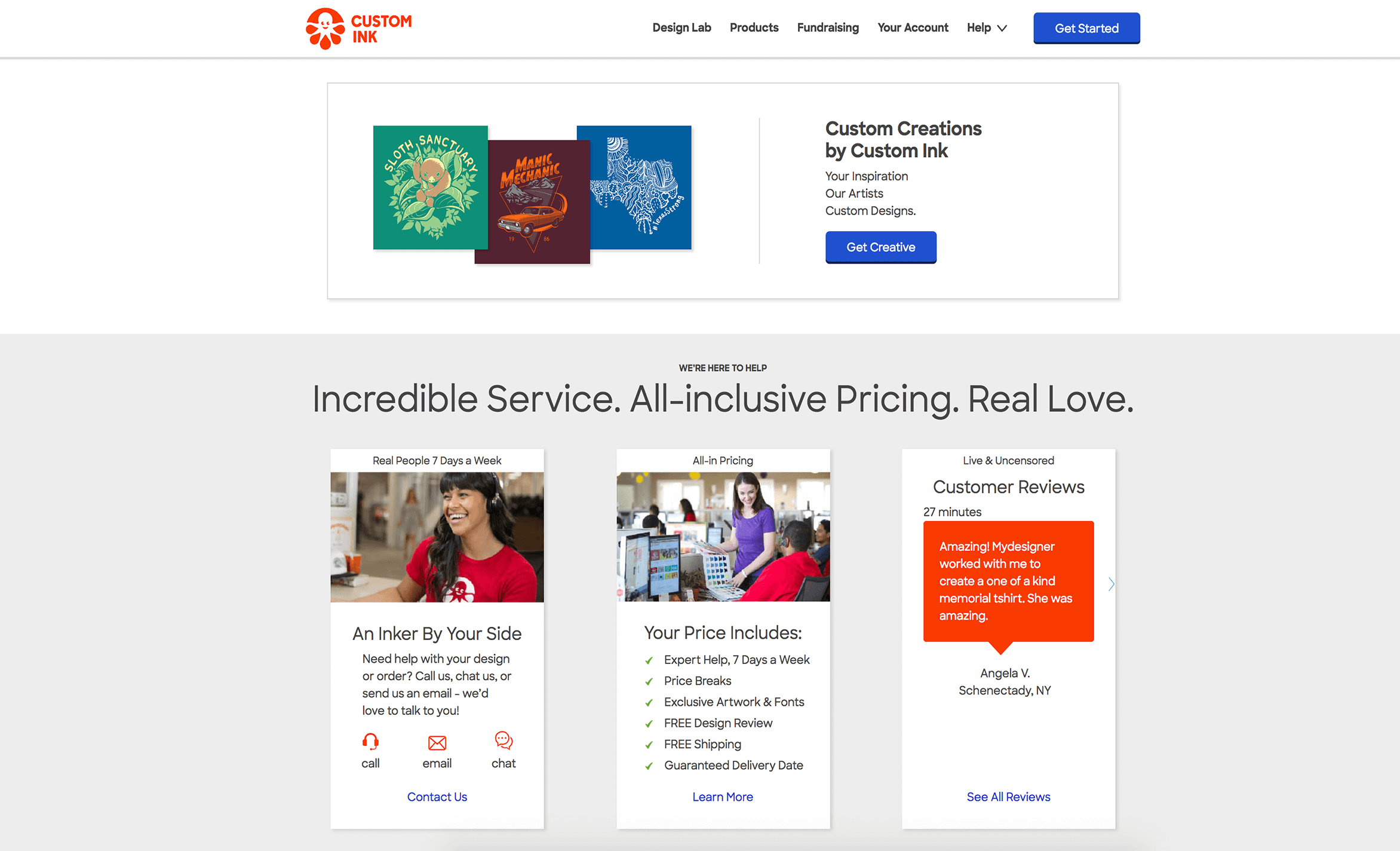
Below are three personas we created. The shopper would be a regular user who would buy items from an e-commerce site, the artist is the person who would sell their items that they've created, and the employee is a user who would be updating the site regularly to keep it up to date.



Funky Zebra will design and develop an e-commerce site for Trend Central that includes a widget for simple customization of products. As of now, we will not make an accompanying mobile app, but we are open to developing one after launching this e-commerce website. We will help Trend Central in hitting their short term objective which is, to increase their sales. In order for Trend Central to hit their goal, Funky Zebra will establish a strong web presence for Trend Central and have a good SEO (search engine optimization) ranking.
By the end of this project, Trend Central will have a fully functional responsive website.
• Most functionality built in from chosen e-commerce site including shopping cart, shipping details, state sales tax issues, secure online payment processing and order tracking.
• Guidance on payment methods and processing fees during first year.
• User ability to search entire site.
• Product database that can be browsed by artist or category.
• Secure user database (opening account, user agreement, set password etc.).
• Forms on site to be emailed to recipients and stored.
• Widget for users to personalize products by applying graphics.
• File upload availability for users, for staff to review and approve however each time.
• Staff availability to approve pending new products and modify old products.
• Community building features including blog, user comments, and opt-in promotional emails.
• Links to the major social media sites.
• Banner ads.
• Automatic statistics on use of site after launch including geographic data, top users, pages, hits etc.
• Comply with section 508 of the Workforce Investment Act 1998.
• Advertising
• PR
• Web hosting
• Web maintenance after 30 days
• Brand identity
• Videos
• Audio
• Product images
• All copy
• Mobile app
• QR code generation
• Frequent buyer program
• Homepage will feature new items and special promotions. Primary navigation options will include Shop, Create, Blog, Info:
• Shop = by category and by artists (men, women's accessories).
• Create = widget (ability to scale and see multiple views, upload and apply graphics).
• Blog = read
• Info = log into your account (track orders), company information.
• Each artist will be able to put together a simple storefront to display the items that he or she has customized - we need to provide them with a few options for set up for 20 artists.
• Widget for users to personalize products by applying graphics.
• Continuous use of provided identity guidlines for fonts colors, and graphic treatments.
• A Scalable solution with a consistent interface matching your identity.
• Favicon within your guildlines provided.
• Clean, contemporary, innovative, creative, savvy, fresh, dynamic, hip design.
• Similar to that of Etsy, Cafe Press & Threadless.
• Site working similarly across all modern browsers (Chrome, IE, Firefox, Safari) and operating systems (desktop and mobile - responsive site optimized for both mobile phones and tablets).
To be able to measure Trend Central’s success, we will track their traffic using these seven methods:
The most common way to measure a website’s success is by how users visit their website.
We will be using Google Analytics to count how many people visit their site per day. Website traffic results are also a good indication if the website is either growing, stagnating, or declining. It can also tell us what the most popular item is.
Website traffic can also be broken down into unique or repeat visits by users. Repeat visits show if there are any loyal customers.
Traffic sources will tell you where your traffic is coming from. Google Analytics will show where or how your users discover your website.
Google Analytics breaks down the traffic sources into four categories:
a. Organic Search: traffic coming from search engines.
b. Referral: traffic from another website.
c. Direct: traffic from typing down your domain name into the browser.
d. Social: traffic from social media.
A bounce rate is the percentage of visitors who leave the website after visiting only one page from the site.
Having a high bounce rate also will have an impact on your SEO (search engine optimization). The bounce rate metric is measured in percentage and tells you how many visitors leave your website within seconds after visiting it. It is better to have a low bounce rate percentage.
As a rule of thumb, a bounce rate in the range of 26 to 40 percent is excellent. 41 to 55 percent is roughly average. 56 to 70 percent is higher than average, but may not be cause for alarm depending on the website. Anything over 70 percent is disappointing.
However, a bounce rate does not tell you why users are leaving the website. Some common reasons for a high bounce rate are slow loading times, broken links/websites, and bad first impressions.
Using the behavior section of Google Analytics, you'll learn about your top pages. Your best performing pages are extremely important because they show which pages and content your audience responds to.
As you begin to work with different styles of content, you'll begin to see and analyze which works best and is most popular with your audience. And knowing that, the rest is simple: create more of that specific type of content.
Conversion Rate is probably the most important metric as it looks at your site's profitability. Increasing your conversion Rate from 1% to 2% is already doubling your profits.
This conversion rate is calculated by: unique visitors/ conversions.
These rates signify how well you encourage your traffic to perform a specific action.
Though each site may have varying qualifications for a conversion, many may have "conversion goals" such as: a sale, a share, or a subscriber.
High conversion rates show a more profitable site whereas a lower conversion rate may signify a poor call to action, an ineffective sales copy, and/or the attraction of the wrong type of traffic.
The average global conversion rate in retail is 2.95% and the average conversion rate in the US market when it comes to retail is 3%.
Though having multiple traffic sources is important, it's also important to calculate the conversion rate by traffic source.
Conversion Rate by traffic source is calculated using the four different traffic sources: organic search, referral, direct, and social.
Looking at these rates, we can see that direct and referral traffic are most valuable whereas organic search and social traffic are not as profitable.
Because not all traffic sources are created equally, knowing the conversion rates of each traffic source will help you target the most valuable target sources and adjust your strategy for more ineffective traffic sources.
The final metric is customer's lifetime value. Though this is tougher to calculate than conversion rates, it's important to consider when setting marketing budgets and forecasting a customer's future activity.
The lifetime metric factors in the customer's potential future purchases into the equation. This is useful information because it helps a company allocate their resources more effectively allowing them to earn more profit. By doing this, their business will continue to grow and expand more quickly.
Although website analytics may look intimidating, the data presented by tracking software are all straightforward. If you are able to track your website’s traffic, you get the true numbers and not just assumptions. If you can improve your website’s metrics, noticeable changes can be seen in the website.
Our recommended tracking software is, Google Analytics. It is very easy to incorporate to any website and the website metrics are very easy to understand. If you just want to check the traffic, bounce rate, and basic information about the website traffic, you may use Google Analytics for free. There is also a paid version which provides more information about the traffic on a website.
Listed below are the following e-commerce websites and web hosting options we've recommened to the client.
Shopify is one of the most famous online shopping cart tools. It’s popular with small shops because that is the market Shopify is aiming to serve.
Price: Starter: $29/month, Pro: $79/month, Advanced $299/month.
Example: http://www.ASPEN.com
Templates and plugins: with their own theme store and app store, customers can choose from 150+ templates and hundreds of apps.
Shopify experts: Grouped by their expertise, Experts are experienced developers who can help a customer with their Shopify shop.
Hosting with CDN: While hosting certainly isn’t a specific feature (how else would you sell hosted shopping carts?), hooking it up to a CDN sure is.
Mobile: Your visitors can see a optizimed mobile version of your site, and you can control your shop on your mobile.
Big Commerce is the most popular online shopping cart in the "top million" sites category, which means it's popular for for small to medium-sized web stores. It offers more features to grow your sales than almost anby other shopping cart software in the market.
Price: Standard $29.95/month, Plus $79.95/month, Advanced $249.95/month.
Example: http://www.sonofasalior.com
Integrated education: Big Commerce puts a ton of focus on helping you learn how to build a successful online store. They have a Big Commerce University with very in-depth videos, how-to guides built right into your store's dashboard, a set-up wizard, an auto responder email series during sign-up, and a consultant who answers any questions right off the bat.
No hassle speed and security: An all-in-one online store solution like Big Commerce allows you to turn all those hassles over to professionals. Instead of struggling with the built-in plugin.
Built-in marketing feature: Built-in marketing features are a huge pro for choosing Big Commerce, especially if you’re just starting out selling online and not entirely sure where your marketing should even begin.
Helpful customer service: Big Commerce not only assigns you a dedicated “consultant,” they also have active forums, a huge learning knowledge-base, support via Facebook, Twitter, chat, email, and phone.
Magento successfully integrates digital and physical shopping experiences, delighting customers. In addition to its flagship open source commerce platform, Magento boasts a strong portfolio of cloud-based omnichannel solutions including in-store, retail associate, and order management technologies.
Price: Basic $59/month, Small Business $199/month, Professional $399/month.
Flexibility: The architecture of Magento allows you to customize templates and to develop functionality according to your needs as this is an open source platform.
Feature-rich: Magento’s community version allows you to manage multiple storefronts, multi-location, multi-currency, multi-language with a user-friendly UI and easy navigation.
Pricing: The community version is free for small to medium sized businesses. Magento Enterprise costs $18,000 per year for enterprise business solution.
Community: Magento has large community users, who have developed many plugins and extensions, which will help you in real-time. Apart from that, it has a simple backend and organized store that can be easily manageable.
In summary, each platform provided has it’s own benefits and features that sets itself apart from the others. Based off of your request for proposal the hosting option we would recommend for you would be Shopify. Although on paper, the most expensive, it gives you a lot more for your money and includes greater features and flexibility for you and what you are trying to achieve with your site. It matches up greater than the others with regard to features and aspects requested by you and as such to us would therefore provide you with best opportunity to hit your target sales.
There will be a total of four phases for the development process of the website.
Goal:
In order for us to develop a successful website, careful planning will have to take place. The client will play a big role in this phase since all the content will be coming from them This is also the most important step in a web design project, because this is where all the content will be collected and what to put in the website. By the end of this phase, we will have a site map.
What's included in Phase 1:
1. Internal kickoff with the Funky Zebra team
2. Client meeting with Trend Central
3. Understand what the client needs
4. Analysis of their content plan
5. Collect necessary data from the client
Milestone:
Come up with a data plan for Trend Central.
Duration of Phase 1:
4 weeks
Total fees:
$32,110.00
Total expenses:
$164.00
Phase 1 subtotal:
$32,274.00
Goal:
To come up with a website design based on the client’s requirements and needs. In order for us to be able to follow the 5 week timeline, the client would have to be hands on during the revision and review stages.
What's included in Phase 2:
1. strategy session and design brief
2. Internal meeting
3. Internal kick-off
4. Homepage design (version 1)
5. Homepage design review (on version 1)
6. Homepage design revisions (on versions 2 & 3)
7. Homepage design review (on versions 2 & 3)
8. Inner page designs (version 1)
9. Inner page design review (on version 1)
10. Inner page design revisions (versions 2 & 3)
11. Final design revisions (internal)
12. Final design review (internal)
Milestone:
To get a design sign-off from the client.
Duration of Phase 2:
5 weeks
Total fees:
$37,080.00
Total expenses:
$3,870.00
Phase 2 subtotal:
$40,950.00
Goal:
To have the website uploaded to the client’s server.
What's included in Phase 2:
The more custom the design and functionality a website has, the longer the development phase. The kinds of things that will extend the development time and put you into an intermediate or advanced project timeline are the following, e-commerce platform, sign-up system, reservation systems, listing systems, directories, etc. This phase will also have the most
Listed below are the development steps:
1. Slicing the images needed for the website
2. Setting up a database
3. Designing a global stylesheet (CSS) that is compatible across all browsers
4. Homepage development and coding: Header, configurable nav bar/menu, jQuery sliders, widgets, body, custom elements, and a footer
5. Inner pages development and coding: pages, body, sidebars, widgets, etc.
Milestone:
To get client feedback.
Duration of Phase 3:
10 weeks
Total fees:
$71,940.00
Total expenses:
$480.00
Phase 2 subtotal:
$72,420.00
Goal:
To have users test out the website and have the client approve the website for launching. We have come up with a QA checklist, if the website has completed everything, it is ready for launching
What's included in Phase 4:
1. Design quality
2. Testing
3. Approval
4. Support
Checklist:
☐ Check for broken lines
☐ Compare design to mockups
☐ Check site architecture
☐ Open website in all browsers and devices
☐ Resize window browser for any page breaks
☐ Review headers, footer, nav bar, and content in every page
☐ Click on all links to see if there are any dead links
☐ Check if all forms are functioning and confirm if it's being received by the server
☐ Check for any spelling format errors
☐ Check for alignment issues across all browsers and devices
☐ Check all title and meta tags for SEO
☐ Check image for alt tag
☐ Check if website is SSL compliant
Milestone:
To launch the website.
Duration of Phase 3:
9 weeks
Total fees:
$61,620.00
Total expenses:
$1,200.00
Phase 2 subtotal:
$62,820.00
The whole development process will take approximately eight months.
Click here to view the Gantt chart.